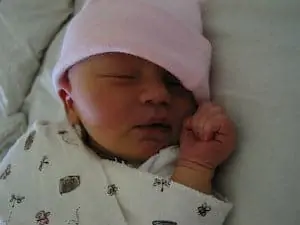Swaddling is something the American Academy of Pediatrics (AAP) recommends for infants and young babies. Yet, they also talk about not putting blankets in the crib. And you have to swaddle with a blanket.
It’s no wonder I get so many messages from concerned mamas that aren’t sure what to do. Hopefully, I can help remove some of that worry.
Nothing is entirely risk-free, even swaddling. But when you know safe swaddling techniques, you minimize the risks involved.
There’s always a risk when you eat that you’ll choke. Or that when you walk up or downstairs, you’ll trip and fall. We put ourselves at risk numerous times a day, yet those risks are statistically minimal.
I absolutely understand the mental aspect of this but overthinking isn’t going to help. So what will? Safe swaddling techniques! When you do it the right way and follow everything, you (and baby) can sleep soundly. Until feeding time, but that’s another story.
I’ve been talking about swaddling so much lately; it’s made me think of when both my girls were little bitty things. I practiced on larger stuffed animals before my eldest was born. Of course, it’s very different when you have a squirming baby to wrap up. But once you do it a few times, you’ll be a pro!
Plus, they make swaddle blankets that stay in place so you won’t need to worry about it coming undone and covering the baby’s face in the night.
But another potential danger of swaddling is how you swaddle so you don’t hinder her hips. There’s a happy-medium for a swaddle where it is snug yet not too tight.
So, what are safe swaddling techniques, and what mistakes should you avoid making? Keep reading for my full list on everything about swaddling safely, followed by some popular questions I’ve been asked recently.
1. Make your swaddle snug but not tight
I know what you’re going to say. “But Leslie, how do I know it’s not too tight? I’m not the one wearing a swaddle!” That’s an excellent question, but there is a very simple way to tell.
Take 2 or 3 fingers and put them between the blanket and baby’s chest at the top of the swaddle. If they fit, you’ve got it just right. As for the bottom, it should be loose enough so your babies legs are bent and can spread out.
2. Baby got back (sleep)
This is true even when you don’t swaddle, but the baby should be placed on her back to sleep. If you’re using a swaddle blanket, everything should be all bundled up. But if you have any excess at the bottom, tuck it under your baby.
3. Mind the temperature
Babies can’t regulate their own temperatures, which is why swaddling can lead to SIDS if you let her overheat. Wherever your baby sleeps, set the room at the right temperature (that’s somewhere between 68F and 72F all year).
4. Don’t shove baby in extra layers

A regular pair of baby pajamas plus a swaddle blanket will be just right for keeping your baby safe and comfortable. Keep an eye on your baby to see if she’s sweaty, her hair gets damp, cheeks are flushed, breathing is rapid, or she has a heat rash. If you see these things, you’ve got her too hot and need to unbundle her.
5. Only swaddle for sleep and naps
With safe swaddling techniques, your baby will have more sound rest at night and during naps too. But during wakeful hours, don’t swaddle your baby. She needs room to move around, tummy time, and chances to develop those fine motor skills. Here’s what to do if she doesn’t want to do tummy time.
6. Only baby (and what she’s wearing) go into the crib
I know, I know, I knowwwwww. Those catalogs with all the pretty baby stuff for your nursery look so amazing. Unfortunately, much of those things aren’t just unnecessary at this stage of your child’s life…they’re dangerous too.
In the crib, you should never have pillows, loose blankets, stuffed animals, or those dangerous bumpers. They’re all suffocation hazards. All you need for your baby in the crib is a tight-fitting sheet on the mattress and your baby wrapped with safe swaddling techniques.
7. Use the right kind of blanket
You will likely get swaddle blankets at your baby shower. But even if you don’t, you can use a receiving blanket since it’s a good size. The blanket you use should be of breathable fabric and not too thick either. Don’t use anything that would come loose over the face and pose a suffocation danger.
8. Signs of rolling mean stop swaddling

Once your baby can roll over or escape from the swaddle, it’s time to stop. You can start swaddling with arms out at this point if the baby has trouble sleeping without a swaddle. You can also get one of those wearable blankets, which makes a nice transition.
In general, babies shouldn’t be swaddled once they reach that 4-month mark. My eldest was over it on the first day of the 4th month while my youngest was still clinging to the swaddle, so we had to leave her arms out until she was finally comfortable with us not swaddling her legs.
9. Check that you’ve wrapped your swaddle smartly and securely
One of the best safe swaddling techniques is to form a V-neck so there’s little chance the blanket can get over your baby’s face. The other thing is that it needs to be secure. If your baby has a self-soothing habit by touching her face or sucking her fingers, you can use the arms out swaddle to let her feel more comfortable.
10. Put baby in her own space to sleep
There is a greater chance of suffocation with swaddling when you bed-share. And it’s not just swaddling; it’s with bed-sharing. So if you want your baby to sleep in the bed with you, get a baby nest to minimize risks.
11. Watch those hips
Don’t make the mistake of wrapping the baby perfectly on top but hindering her leg movement. Baby should be able to move her legs around freely. The swaddle blankets you choose should be hip-healthy as per what the International Hip Dysplasia Institute says.
12. Don’t swaddle too high on baby’s shoulder
For perfect safe swaddling techniques, you should make sure your swaddle starts just below your baby’s shoulders. It should not be above the neckline. Babies wiggle and jiggle about, so if that swaddle is too high, it can come over her face, and that’s something you don’t want to even think about.
13. Never use swaddling to calm a baby
Swaddling indeed is calming for your baby. It mimics that cozy feeling she had in the womb. But before you swaddle her up, make sure you’ve gone through all the other list of her needs to stop her from crying. Is it time for a feeding? Did you remember to burp her? Uh oh…it smells…did she poop?
Check all these things first and make sure the baby’s needs have been met before you bundle her up like a burrito.
14. Never use a swaddle in a car seat
And of course, no matter how excellent your swaddling technique may be, do not ever EVER put a swaddled baby in the car seat. You won’t be able to put the harness on correctly. Another place you shouldn’t put a swaddled baby? Those infant swings or chairs.
If you want to keep the baby warm in the car, they make car seat covers like this one, for example. These will allow you to fasten your baby into the car seat correctly while keeping her warm on a frosty day.
Ask Leslie: You Asked, I Answered!
I am so happy to get so many questions from all the mamas out there. Please feel free to ask anything because that’s what I’m here for. I hope I can help put your mind at ease. I’ve covered some of these before, but I’ll go through them again. These are the questions I receive the most inquiries about.
Is it safe to swaddle a newborn at night?
Oh, yes! It absolutely is. The AAP recommends it, but there is a big BUT here, and that is you need to follow safe swaddling techniques. Go through what I’ve got above and make a checklist to run through every night.
That list should include:
- Did I use a proper swaddling blanket?
- Is it too snug?
- Is it too loose?
- Is the blanket too large or too thick?
- Is baby over-bundled with clothes under that blanket?
- Is baby on her back?
Think about these questions, and you’ll know if your baby is safe at night.
How do you safely swaddle?

In a nutshell, you’ll use a swaddle blanket and secure it as shown with Velcro or whatever attachments it has. For other blankets, make sure it is no more than 44″ x 44″ in size, not too thick, and that you place the top part just below the shoulders. Legs should be able to move freely in there too.
I’ve got more details about how to swaddle safely in this post, so please read up for the full story.
What should you not swaddle a baby in?
When trying to swaddle your baby, never choose a blanket that is too large. This creates excess fabric which, if baby breaks out of the swaddle, can cover her precious face. Another thing to avoid: thick blankets. Choose something lightweight and breathable. Muslin is a great fabric for swaddling.
Can a baby suffocate from a swaddle?
Yes, tragically, this can happen. It is unlikely to happen though when you use safe swaddling techniques as I’ve mentioned above and in my recent swaddling posts.
Something I like to recommend to new mamas is to have the nurses at the hospital show you how to swaddle. My breastfeeding coach Vivien had helped me too when she visited us at the hospital for my eldest. Practicing with someone that’s a pro at swaddling will ensure you get the technique right.
Is it safe to swaddle a baby in a crib?
Yes, it absolutely is safe to swaddle your baby in a crib. Make sure you use the right kind of blanket (not too big or too thick), that you’ve swaddled correctly, and that nothing else at all is in the crib.
Does swaddling make gas worse?
No, it can actually help! Swaddling can help quell colic. This gassy situation can cause your baby to cry inconsolably or fuss away in the night. My eldest was like this and swaddling was amazing for her.
What should I do if my baby doesn’t like to be swaddled?
First, evaluate the age of your baby. If she’s still in that newborn to 4-month-old group, try swaddling her with her arms up or her arms out of the swaddle. You can also experiment with leaving her legs out and simply swaddling the arms. Every baby is different, but trying these options may help. More about here if the baby fights swaddles.
I wrote more detailed instructions on how to swaddle with arms up and swaddle with arms out, so check that out for a good how-to.
Final Thoughts on Safe Swaddling Techniques
I’ve said it before, but mamas like us, we’re programmed to worry. It’s what we do! But worrying really gets us nowhere. Instead, work on your swaddling techniques. Ask professionals (nurses, doulas, doctors, etc.) to help you. Choose the right swaddling items. And when you do, you can feel confident that your safe swaddling techniques will give you all a reason to sleep soundly at night.
Leslie Berry lives with her husband and two young daughters in Los Altos, California, where she loves helping other moms get comfortable with motherhood and embracing the insanity with facts peppered with laughs.
She loves eating too much sushi, exercising, and jamming out on her Fender. Read more about Leslie here.






